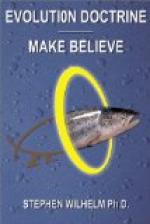But even if an animal of the past possessed hard structures, it must have satisfied certain limited conditions to have its remains prove serviceable to students of to-day. A dead mammal must fall upon ground that has just the right consistency to receive it; if the soil is too soft, its several parts will be separated and scattered as readily as though it had fallen upon hard ground where it would be torn to pieces by carnivorous animals. The dead body must then be covered up by a blanket of silt or sand like that which would be deposited as the result of a freshet. If a skeleton is too greatly broken up or scattered, it may be difficult or even impossible for its discoverer to piece together the various fragments and assemble them in their original relations. Very few individuals have been so buried and preserved as to meet the conditions for the formation of an ideal fossil. To realize how little may be left of even the most abundant of higher organisms, we have only to recall that less than a century ago immense herds of bison and wild horses roamed the Western plains, but very few of their skulls or other bones remain to be enclosed and fossilized in future strata of rocks. When we appreciate all these difficulties, both geological and biological, we begin to see clearly why the ancient lines of descent cannot be known as we know the path and mode of embryonic transformation. The wonder is not that the palaeontological record is incomplete, but that there is any coherent and decipherable record at all. Yet in view of the many and varied obstacles that must be surmounted by the investigator, and the adverse factors which reduce the available evidence, the rapidly growing body of palaeontological facts is amply sufficient for the naturalist to use in formulating definite and conclusive principles of evolution.
* * * * *
For the purposes of palaeontology, the most essential data of geology are those which indicate the relative ages of the strata that make up the hard outer crust of the earth, for only through them can the order of animal succession be ascertained. It does not matter exactly how old the earth may be. While it is possible to determine the approximate length of time required for the construction of sedimentary rocks like those which natural agencies are producing to-day, there are few definite facts to guide speculation as to the mode or duration of the process by which the first hard crystalline surface of the earth was formed. But palaeontology does not care so much about the earliest geological happenings, for it is concerned with the manifold animal forms that arose and evolved after life appeared on the globe. Questions as to the way life arose, and as to the earliest transformations of the materials by which the earth was first formed are not within the scope of organic evolution, although they relate to intensely interesting problems for the student of the process of cosmic evolution.




